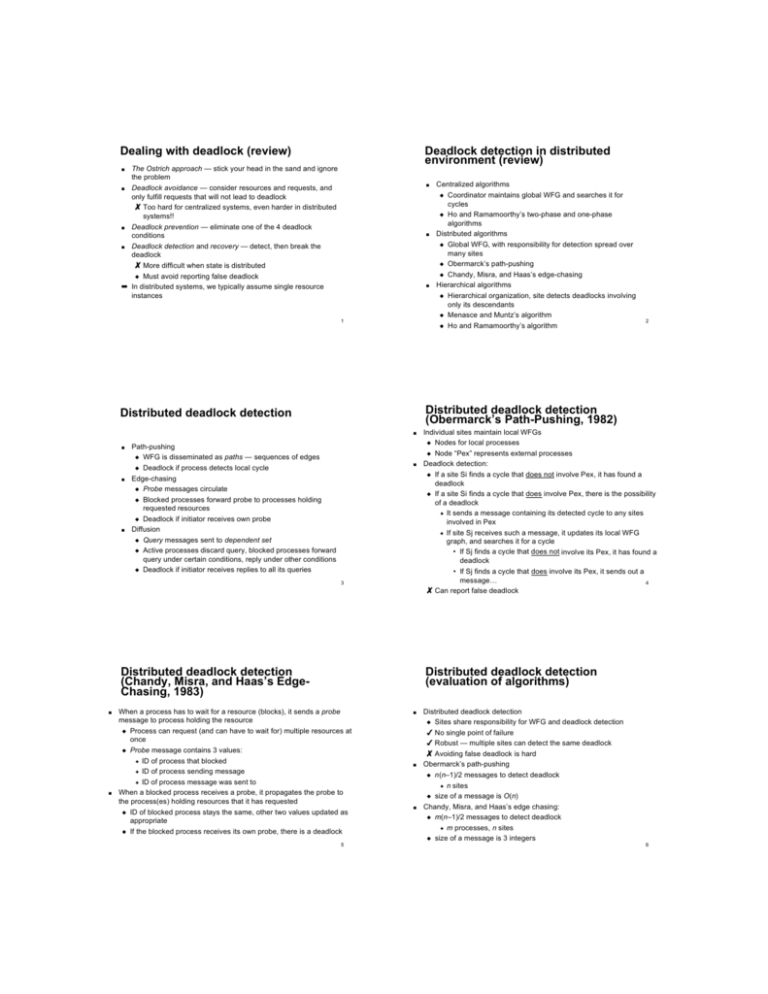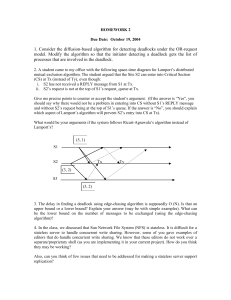Deadlock Detection in Distributed Systems
advertisement

Dealing with deadlock (review) Deadlock detection in distributed environment (review) The Ostrich approach — stick your head in the sand and ignore the problem Deadlock avoidance — consider resources and requests, and only fulfill requests that will not lead to deadlock 8Too hard for centralized systems, even harder in distributed systems!! n Deadlock prevention — eliminate one of the 4 deadlock conditions n Deadlock detection and recovery — detect, then break the deadlock 8More difficult when state is distributed u Must avoid reporting false deadlock á In distributed systems, we typically assume single resource instances n n n n n 1 n n n Path-pushing u WFG is disseminated as paths — sequences of edges u Deadlock if process detects local cycle Edge-chasing u Probe messages circulate u Blocked processes forward probe to processes holding requested resources u Deadlock if initiator receives own probe Diffusion u Query messages sent to dependent set u Active processes discard query, blocked processes forward query under certain conditions, reply under other conditions u Deadlock if initiator receives replies to all its queries n 3 Distributed deadlock detection (Chandy, Misra, and Haas’s EdgeChasing, 1983) n n 2 Distributed deadlock detection (Obermarck’s Path-Pushing, 1982) Distributed deadlock detection n Centralized algorithms u Coordinator maintains global WFG and searches it for cycles u Ho and Ramamoorthy’s two-phase and one-phase algorithms Distributed algorithms u Global WFG, with responsibility for detection spread over many sites u Obermarck’s path-pushing u Chandy, Misra, and Haas’s edge-chasing Hierarchical algorithms u Hierarchical organization, site detects deadlocks involving only its descendants u Menasce and Muntz’s algorithm u Ho and Ramamoorthy’s algorithm Individual sites maintain local WFGs u Nodes for local processes u Node “Pex” represents external processes Deadlock detection: u If a site Si finds a cycle that does not involve Pex, it has found a deadlock u If a site Si finds a cycle that does involve Pex, there is the possibility of a deadlock F It sends a message containing its detected cycle to any sites involved in Pex F If site Sj receives such a message, it updates its local WFG graph, and searches it for a cycle • If Sj finds a cycle that does not involve its Pex, it has found a deadlock • If Sj finds a cycle that does involve its Pex, it sends out a message… 4 8Can report false deadlock Distributed deadlock detection (evaluation of algorithms) When a process has to wait for a resource (blocks), it sends a probe message to process holding the resource u Process can request (and can have to wait for) multiple resources at once u Probe message contains 3 values: F ID of process that blocked F ID of process sending message F ID of process message was sent to When a blocked process receives a probe, it propagates the probe to the process(es) holding resources that it has requested u ID of blocked process stays the same, other two values updated as appropriate u If the blocked process receives its own probe, there is a deadlock 5 n n Distributed deadlock detection u Sites share responsibility for WFG and deadlock detection 4 No single point of failure 4 Robust — multiple sites can detect the same deadlock 8Avoiding false deadlock is hard Obermarck’s path-pushing n(n–1)/2 messages to detect deadlock F n sites u size of a message is O(n) Chandy, Misra, and Haas’s edge chasing: u m(n–1)/2 messages to detect deadlock F m processes, n sites u size of a message is 3 integers u n 6 Hierarchical deadlock detection n n Sites are organized hierarchically u A site is only responsible for detecting deadlocks involving its children sites Menasce and Muntz, 1979 u Sites (called controllers) are organized as a tree F Leaf controllers manage resources • Each maintains a local WFG concerned only about its own resources F Interior controllers are responsible for deadlock detection • Each maintains a global WFG that is the union of the WFGs of its children • Detects deadlock among its children u Whenever a controller changes its WFG due to a resource request, it propagates that change to its parent F Parent updates its WFG, and searches it for cycles, propagates changes upward Hierarchical deadlock detection (cont.) n 7 8 Deadlock recovery Perspective n n n Correctness of algorithms u There are few formal methods to prove the correctness of deadlock detection algorithms — we usually use informal or intuitive arguments Performance u Usually measured as the number of messages exchanged to detect deadlock F Deceptive since message are also exchanged when there is no deadlock F Doesn’t account for size of the message u Should also measure: F Deadlock persistence time (measure of how long resources are wasted) • Tradeoff with communication overhead F Storage overhead (graphs, tables, etc.) F Processing overhead to search for cycles 9 F Time to optimally recover from deadlock Deadlock recovery (cont.) n Ho and Ramamoorthy, 1982 u Sites are grouped into disjoint clusters u Periodically, a site is chosen as a central control site F Central control site chooses a control site for each cluster u Control site collects status tables from its cluster, and uses the Ho and Ramamoorthy one-phase centralized deadlock detection algorithm to detect deadlock in that cluster u All control sites then forward their status information and WFGs to the central control site, which combines that information into a global WFG and searches it for cycles u Control sites detect deadlock in clusters F Central control site detects deadlock between clusters Any less drastic alternatives? Preempt resources u One at a time until no deadlock u Which “victim”? F Again, based on cost, similar to CPU scheduling u Is rollback possible? F Preempt resources — take them away F Rollback — “roll” the process back to some safe state, and restart it from there • OS must checkpoint the process frequently — write its state to a file F Could roll back to beginning, or just enough to break the deadlock • This second time through, it has to wait for the resource • Has to keep multiple checkpoint files, which adds a lot of overhead u Avoid starvation F May happen if decision is based on same cost factors each 11 time F Don’t keep preempting same process (i.e., set some limit) n How often does deadlock detection run? u After every resource request? u Less often (e.g., every hour or so, or whenever resource utilization gets low)? What if OS detects a deadlock? u Terminate a process F All deadlocked processes F One process at a time until no deadlock • Which one? One with most resources? One with less cost? – CPU time used, needed in future – Resources used, needed • That’s a choice similar to CPU scheduling F Is it acceptable to terminate process(es)? • May have performed a long computation – Not ideal, but OK to terminate it • Maybe have updated a file or done I/O 10 – Can’t just start it over again!






